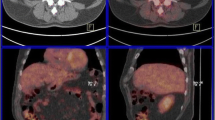Abstract
Background
The role of fusion positron emission tomography/computed tomography scans (PET/CT) in staging of patients with pancreatic neoplasms (PN) is poorly defined. PET/CT may serve as an adjunct to standard imaging by increasing occult metastases detection. The purpose of this study was to assess the additional value, in relation to computed tomography (CT), of PET/CT imaging for patients with PN.
Methods
Eighty-two patients with potentially resectable PN underwent staging with PET/CT and CT of the chest and abdomen. Sensitivity of diagnosing pancreatic cancer by PET/CT avidity was evaluated. The sensitivity of detecting metastases was compared between PET/CT, standard CT, and the combination of PET/CT and CT. The impact of PET/CT on patient management was estimated by calculating the percentage of patients whose treatment plan was altered due to PET/CT.
Results
The sensitivity and specificity of PET/CT in diagnosing pancreatic cancer were 89% and 88%, respectively. Sensitivity of detecting metastatic disease for PET/CT alone, standard CT alone, and the combination of PET/CT and CT were 61%, 57%, and 87%, respectively. Findings on PET/CT influenced the clinical management in seven patients (11%), two with a supraclavicular lymph node (LN), two occult liver lesions, two peritoneal implants, and one peri-esophageal LN.
Conclusion
This study evaluated PET/CT in the initial work-up of patients with PN. PET/CT increased sensitivity (87%) for detection of metastatic disease when combined with standard CT. In invasive cancer, PET/CT changed the management in 11% of our patients. PET/CT should be considered in the initial work-up of patients with potentially resectable pancreatic lesions.



Similar content being viewed by others
References
Jemal A, Siegel R, Ward E, et al. Cancer Statistics, 2008. CA Cancer J Clin. Feb 20 2008
Oettle H, Post S, Neuhaus P, et al. Adjuvant chemotherapy with gemcitabine vs observation in patients undergoing curative-intent resection of pancreatic cancer: a randomized controlled trial. JAMA 2007; 297:267–77
Regine WF, Winter KA, Abrams RA, et al. Fluorouracil vs gemcitabine chemotherapy before and after fluorouracil-based chemoradiation following resection of pancreatic adenocarcinoma: a randomized controlled trial. JAMA 2008; 299:1019–26
Gastrointestinal Tumor Study Group. Further evidence of effective adjuvant combined radiation and chemotherapy following curative resection of pancreatic cancer. Cancer 1987; 59:2006–10
Neoptolemos JP, Stocken DD, Friess H, et al. A randomized trial of chemoradiotherapy and chemotherapy after resection of pancreatic cancer. N Engl J Med 2004; 350:1200–10
Abdel-Nabi H, Doerr RJ, Lamonica DM, et al. Staging of primary colorectal carcinomas with fluorine-18 fluorodeoxyglucose whole-body PET: correlation with histopathologic and CT findings. Radiology 1998; 206:755–60
Ruers TJ, Langenhoff BS, Neeleman N, et al. Value of positron emission tomography with [F-18]fluorodeoxyglucose in patients with colorectal liver metastases: a prospective study. J Clin Oncol 2002; 20:388–95
Brady MS, Akhurst T, Spanknebel K, et al. Utility of preoperative [(18)]f fluorodeoxyglucose-positron emission tomography scanning in high-risk melanoma patients. Ann Surg Oncol 2006; 13:525–32
Bruzzi JF, Munden RF, Truong MT, et al. PET/CT of esophageal cancer: its role in clinical management. Radiographics 2007; 27:1635–52
Zimny M, Bares R, Fass J, et al. Fluorine-18 fluorodeoxyglucose positron emission tomography in the differential diagnosis of pancreatic carcinoma: a report of 106 cases. Eur J Nucl Med 1997; 24:678–82
Imdahl A, Nitzsche E, Krautmann F, et al. Evaluation of positron emission tomography with 2-[18F]fluoro-2-deoxy-D-glucose for the differentiation of chronic pancreatitis and pancreatic cancer. Br J Surg 1999; 86:194–9
Kalra MK, Blake MA, Saini S. Role of dual PET/CT scanning in abdominal malignancies. Cancer Imaging 2004; 4:121–3
Zimny M, Buell U. 18FDG-positron emission tomography in pancreatic cancer. Ann Oncol 1999; 10(Suppl 4):28–32
Keogan MT, Tyler D, Clark L, et al. Diagnosis of pancreatic carcinoma: role of FDG PET. AJR Am J Roentgenol 1998; 171:1565–70
Heinrich S, Goerres GW, Schafer M, et al. Positron emission tomography/computed tomography influences on the management of resectable pancreatic cancer and its cost-effectiveness. Ann Surg 2005; 242:235–43
Ruers TJ, Langenhoff BS, Neeleman N, et al. Value of positron emission tomography with [F-18]fluorodeoxyglucose in patients with colorectal liver metastases: a prospective study. J Clin Oncol 2002; 20:388–95
Mansour JC, Schwartz L, Pandit-Taskar N, et al. The utility of F-18 fluorodeoxyglucose whole body PET imaging for determining malignancy in cystic lesions of the pancreas. J Gastrointest Surg 2006; 10:1354–60
Frohlich A, Diederichs CG, Staib L, et al. Detection of liver metastases from pancreatic cancer using FDG PET. J Nucl Med 1999; 40:250–5
Jadvar H, Fischman AJ. Evaluation of pancreatic carcinoma with FDG PET. Abdom Imaging 2001; 26:254–9
Maemura K, Takao S, Shinchi H, et al. Role of positron emission tomography in decisions on treatment strategies for pancreatic cancer. J Hepatobiliary Pancreat Surg 2006; 13:435–41
Sloka JS, Hollett PD. Cost effectiveness of positron emission tomography in Canada. Med Sci Monit 2005; 11:PH1–6
Maisey NR, Webb A, Flux GD, et al. FDG-PET in the prediction of survival of patients with cancer of the pancreas: a pilot study. Br J Cancer 2000; 83:287–93
Chin BB, Wahl RL. 18F-Fluoro-2-deoxyglucose positron emission tomography in the evaluation of gastrointestinal malignancies. Gut 2003; 52(Suppl 4):iv23–9
Rose DM, Delbeke D, Beauchamp RD, et al. 18Fluorodeoxyglucose-positron emission tomography in the management of patients with suspected pancreatic cancer. Ann Surg 1999; 229:729–37; discussion 737–8
Author information
Authors and Affiliations
Corresponding author
Rights and permissions
About this article
Cite this article
Farma, J.M., Santillan, A.A., Melis, M. et al. PET/CT Fusion Scan Enhances CT Staging in Patients with Pancreatic Neoplasms. Ann Surg Oncol 15, 2465–2471 (2008). https://doi.org/10.1245/s10434-008-9992-0
Received:
Revised:
Accepted:
Published:
Issue Date:
DOI: https://doi.org/10.1245/s10434-008-9992-0




